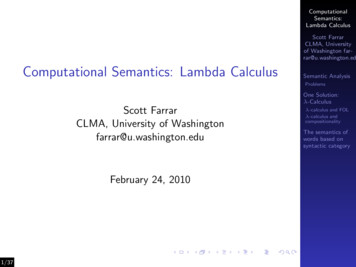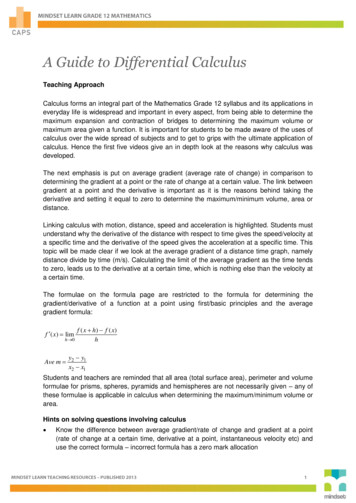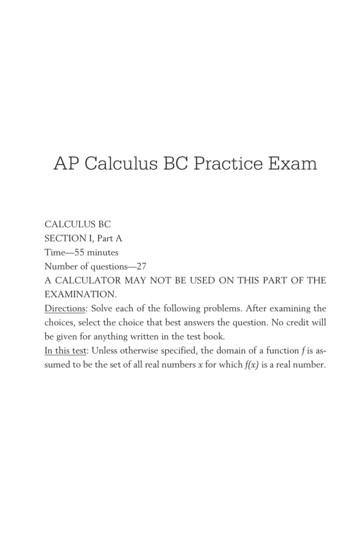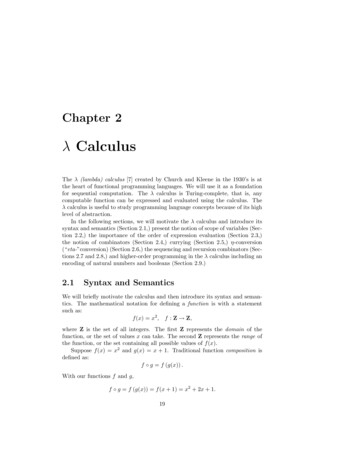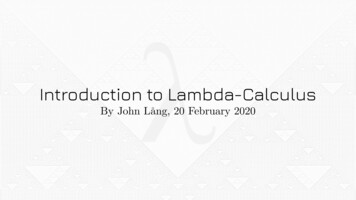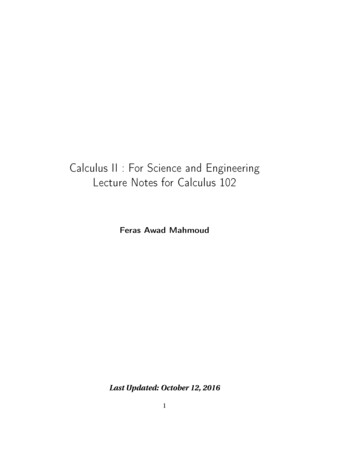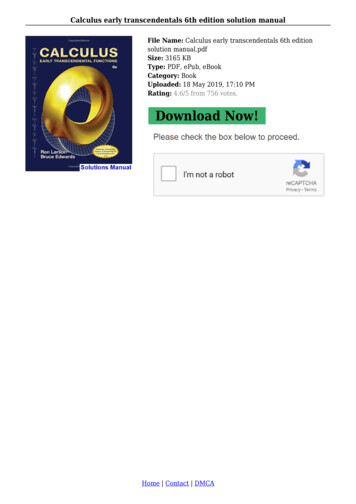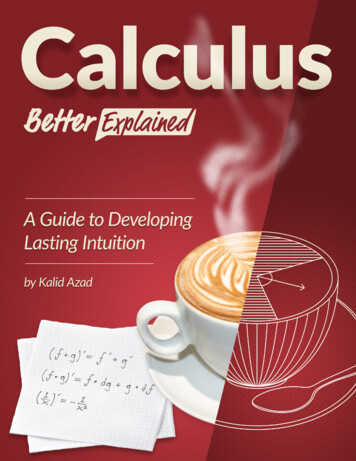
Transcription
C ONTENTSIntroductioni1 1 Minute Calculus: X-Ray and Time-Lapse Vision12 Practicing X-Ray and Time-Lapse Vision53 Expanding Our Intuition114 Learning The Official Terms155 Music From The Machine226 Improving Arithmetic And Algebra257 Seeing How Lines Work298 Playing With Squares359 Working With Infinity4010 The Theory Of Derivatives4411 The Fundamental Theorem Of Calculus (FTOC)4812 The Basic Arithmetic Of Calculus5213 Finding Patterns In The Rules5814 The Fancy Arithmetic Of Calculus6215 Discovering Archimedes’ Formulas68Afterword76Appendix: Learning Checklist78Appendix: Calculus Study Plan80
I NTRODUCTIONHi! It looks like you’re interested in learning Calculus. I like you already.This book isn’t a collection of practice problems or formal theories. Hundredsof textbooks handle that quite well; this is the guide I wish they tucked intotheir front cover.The goal is to help you: Grasp the essence of Calculus in hours, not months Develop lasting, practical insights you can apply to your own life Enjoy a subject often considered humorless Solve an end-to-end problem on your own Build an intuitive foundation for classroom studyMost Calculus courses force you to build the car before driving it. Shouldn’tyou master the physics of acceleration and the chemistry of gasoline beforetouching the wheel? (Sure, if you want to kill someone’s interest in cars.)I’m here to yank you from class, put you in a go-kart, and let you ridearound Calculus Town. Yes, you’ll take control of the wheel (try to avoidthe pedestrians). Yes, you’ll make a few mistakes without perfect knowledgeof the internals. But you’ll be having fun. True understanding comes fromexperiencing ideas yourself, not having them lectured to you.After some practice, you may ignite the curiosity to explore the detailsregular textbooks offer. (How can I go faster? Handle corners better? Which fuelworks best?)A few minutes into Chapter 1, and you’ll visualize what Calculus does. Afteran hour, you’ll analyze concepts using the Calculus lingo and mindset. A fewdays later, after internalizing the ideas, you’ll begin solving famous problems onyour own.So, how do we approach a notoriously difficult subject? Intuition-first.Learning Strategy: Blurry To SharpWhat’s a better learning strategy: covering a subject in full detail from top-tobottom, or progressively sharpening a quick overview?i
INTRODUCTIONiiAfter a single class, which strategy gives you a better understanding of thematerial? Which helps you predict how later parts fit together? Which is morefun?The linear, official, approach doesn’t work for me. Starting with a roughoutline and gradually improving it keeps our interest and helps us see how theindividual details are connected.Most textbooks take the top-down approach, while this book is a blurry-tosharp guide. The fine details are out there when you need them.Learning Strategy: Appreciation To PerformanceNext question: Do you need to be a musician to enjoy a song? No way.There are several levels of music understanding: Intuitive Appreciation: Just enjoying the music. Natural Description: Humming a tune you heard or made up. Symbolic Description: Reading and writing the sheet music. Theory: Explaining how harmonies work, why minor scales are somber,etc. Performance: Playing the official instruments.Math knowledge is the same. Start by appreciating, even enjoying, the idea.Describe it with your own words, in English. Then, learn the official symbols tomake communication easier (“2 3 5” is better than “Two plus three equalsfive”, right?).
INTRODUCTIONiiiWhen we’re ready, we “perform” math by doing the calculations ourselves,and diving into the detailed theory. But only if you want! Decide for yourselfwhat level of understanding you’d like to reach.Here’s a guide to the book, depending on the level you’d like to reach: Intuitive Appreciation (Chapters 1-3) Technical Description (Chapters 4-5) Theory I (Chapters 6-8) Theory II (Chapters 9-14) Performance (Chapter 15)The appendix includes a study plan if you wish to follow a formal course.Learning Strategy: Study HistoryCalculus began when Archimedes realized shapes could be split into partsand rearranged. After a lifetime of effort, he discovered connections betweenspheres, circles and other shapes that were later etched onto his tomb.Unfortunately, Calculus courses are taught out of order. The difficult, modernconcepts are taught first (limits, developed 1800s) and the intuitive foundationsare saved for the end (integrals, imagined 250 B.C.).This book takes Archimedes’ approach: learn to see what Calculus can do,then layer in the theory as needed. By then, your interest has been piqued andyou can read a modern textbook for the details (see recommendations in thefinal chapter).Please don’t feel obligated to reach the Performance level of Calculus. Formost of us (myself included), Appreciation and Description give practical, dayto-day insights. The first few chapters of this course are all that’s needed tohave a better intuition than I had despite dozens of engineering classes.Sound good? Let’s dive in.Email UpdatesBetterExplained.com provides high-quality, intuitive explanations to millions ofreaders each year. If you’d like updates on Calculus and related topics, sign upat:http://betterexplained.com/newsletterBook WebpageNobody likes typing URLs by hand. For clickable links for to the URLs in thisbook, notes, and other resources, visit:http://betterexplained.com/calculus/book
INTRODUCTIONivThe Legal StuffAll content is copyright (c) 2015 Kalid Azad, except the following images usedunder Wikipedia’s Creative Commons license: “Portrait of Isaac Newton” by Sir Godfrey Kneller ler-IsaacNewton-1689.jpg “Tree Rings” by Arnoldius http://commons.wikimedia.org/wiki/File:Tree rings.jpg “Acropoclipse” by Elias Politis e.jpg “Geometric Series” by Indolences http://commons.wikimedia.org/wiki/File:Geometric series 14 square2.svgYou may use any of this material for educational use with attribution;for commercial use, please contact me using http://betterexplained.com/contact.
CHAPTER11 M INUTE C ALCULUS : X-R AY ANDT IME -L APSE V ISIONWe usually take shapes, formulas, and situations at face value. Calculus givesus two superpowers to dig deeper: X-Ray Vision: You see the hidden pieces inside a pattern. You don’t justsee the tree, you know it’s made of rings, with another growing as wespeak. Time-Lapse Vision: You see the future path of an object laid out beforeyou (cool, right?). “Hey, there’s the moon. For the next few days it’ll bewhite, but on the sixth it’ll be low in the sky, in a color I like. I’ll take aphoto then.”1
CHAPTER 1. 1 MINUTE CALCULUS: X-RAY AND TIME-LAPSE VISION2So how is Calculus useful? Well, just imagine having X-Ray or Time-Lapsevision to use at will. For an object or scenario we care about, how was it puttogether? What will happen to it down the line?(Strangely, my letters to Marvel about Calculus-man have been ignored todate.)1.1Calculus In 10 Minutes: See Patterns Step-By-StepWhat do X-Ray and Time-Lapse vision have in common? They examine patternsstep-by-step. An X-Ray shows the individual slices inside, and a Time-Lapse putseach future state next to the other.This seems pretty abstract. Let’s look at the equations for circumference,area, surface area, and volume:We have a vague feeling these formulas are connected, right?
CHAPTER 1. 1 MINUTE CALCULUS: X-RAY AND TIME-LAPSE VISION3Let’s turn on our X-Ray vision and see where this leads. Suppose we knowcircumference 2πr and we want to figure out the equation for area. What canwe do?This is a tough question. Squares are easy to measure, but how do we workout the size of an ever-curving shape?Calculus to the rescue. Let’s use our X-Ray vision to realize a disc is reallyjust a bunch of rings put together. Similar to a tree trunk, here’s a “step-by-step”view of a circle’s area:How does this viewpoint help? Well, let’s unroll those curled-up rings intostraight lines, so they’re easier to measure:
CHAPTER 1. 1 MINUTE CALCULUS: X-RAY AND TIME-LAPSE VISION4Whoa! We have a bunch of straightened-out rings that form a triangle, whichis much easier to measure. (Wikipedia has an animation1 .)The height of each ring depends on its original distance from the center; thering 3 inches from the center would have a height of 2π · 3 inches. The smallestring is a pinpoint, more or less, without any height at all. The height of thelargest ring is the full circumference (2πr ).And because triangles are easier to measure than circles, finding the area isn’ttoo much trouble. The area of the “ring triangle” 12 base·height 12 r (2πr ) πr 2 ,which is the formula for a circle’s area!Our X-Ray vision revealed a simple, easy-to-measure structure within a curvyshape. We realized a circle and a set of glued-together rings were really thesame. From another perspective, a filled-in disc is really just the “time lapse” ofa single ring that grew larger.1.2So. . . What Can I Do With Calculus?Remember learning arithmetic? You learned how to count out a number,and how to combine it with others (add/subtract, multiply/divide, take exponents/roots). Technically, counting isn’t necessary, as our caveman ancestorsdid “fine” (survived) without it.But, having a specific notion of quantity makes navigating the world easier.You don’t have a “big” and “small” pile of rocks: you have an exact count. Youknow how many arrows can be given to each hunter, or whether the gatheredberries are enough for the tribe.Even better, arithmetic gives us metaphors that go beyond strict calculations.It has sharpened our descriptions of everything, letting us clarify everythingfrom spiciness levels and movie ratings (1 to 5) to our mood (1 to 10). Specificmeasurements are a useful idea, and hard to give up once seen.Calculus trains us in two new metaphors: splitting apart and gluing together.A pattern can be separated into parts, and the parts can be progressivelycombined into the full pattern.Is this viewpoint necessary for survival? Nope. But it is interesting.Numbers and equations describe what we have, but Calculus explains thesteps that got us there. Instead of just the cookie, we can see the recipe.Sure, Calculus appears in science because a step-by-step blueprint is moreuseful than being handed a final result. But in everyday scenarios, we have anice perspective to turn on: What steps got us here? Are there any pros or consto that approach? And based on these steps, where are we going next?Let’s feel what a Calculus perspective is like.1 Visit http://betterexplained.com/calculus/book for clickable links to extra resources.
CHAPTERP RACTICING X-R AYAND2T IME -L APSE V ISIONCalculus trains us to use X-Ray and Time-Lapse vision, such as re-arranging acircle into the “ring triangle” we saw in the previous chapter. This makes findingthe area. . . well, if not exactly easy, much more manageable.But we were a little presumptuous. Must every circle in the universe be madefrom rings?Heck no! We’re more creative than that. Here’s a few more ways we couldhave X-Rayed the circle:We could imagine a circle as a set of rings, pizza slices, or vertical boards.Each blueprint is a different step-by-step strategy in action.2.1Ring-by-ring AnalysisUsing your Time-Lapse vision, imagine how the ring-by-ring strategy accumulates over time:What’s interesting about a ring-by-ring progression?5
CHAPTER 2. PRACTICING X-RAY AND TIME-LAPSE VISION6 Each intermediate stage is an entire “mini circle” on its own. i.e., whenwe’re halfway done, we still have a circle, just one with half the regularradius. Each step is an increasing amount of work. Just imagine plowing a circularfield and spreading the work over several days. On the first day, you startat the center and don’t even move. The next, you make take the tightestturn you can. Then you start doing laps, larger and larger, until you arecircling the entire yard on the last day. The work is reasonably predictable, which may help planning. If we knowit’s an extra minute for each lap, then the 20th ring will take 20 minutes. Most of the work happens in the final laps. In the first 25% of thetimelapse, we’ve barely grown: we’re adding tiny rings. Near the end, westart to pick up steam by adding long rings, each nearly the final size.Now let’s get practical: why do trees follow a ring pattern?A big tree must grow from a complete smaller tree. With the ring-by-ringstrategy, we’re always building on a complete, fully-formed circle. We aren’ttrying to grow the “left half” of the tree and then work on the right side.In fact, many natural processes that grow (trees, bones, bubbles, etc.) takethis inside-out approach.2.2Slice-by-slice AnalysisNow think about a slice-by-slice progression. What do you notice? We contribute the same amount with each step. Even better, the partsare identical. This may not matter for math, but in the real world (e.g.,cutting a cake), we want to use the same motion when cutting each slice. Because the slices are symmetrical, we can use shortcuts like making cutsacross the entire shape. These “assembly line” speedups work well whengenerating identical components. Progress is extremely easy to measure. If we have 10 slices, then at slice 6we are exactly 60% done (by both area and circumference). We follow a sweeping circular path, never retracing our steps from an“angular” point of view. When carving out the rings, each step involvedthe full 360 degrees.
CHAPTER 2. PRACTICING X-RAY AND TIME-LAPSE VISION7Let’s think about the real world: what objects use the slice-by-slice pattern,and why?Well food, for one. Cake, pizza, pie: we want everyone to have an equalshare. Slices are simple to cut, we get nice speedups (cutting across the cake),and it’s easy to see how much is remaining. Imagine cutting circular rings froma pie and estimating how much is left.Now think about radar scanners: they sweep a beam in a circle, “clearing”a slice of sky before moving to another angle. This strategy does leave a blindspot in the angle you haven’t yet covered, a tradeoff you’re hopefully aware of.Contrast this to sonar used by a submarine or bat, which sends a sound“ring” propagating in every direction. That works best for close targets (coveringevery direction at once). The drawback is that unfocused propagation getsmuch weaker the further out you go, as the initial energy is spread out over alarger ring. We use megaphones and antennas to focus our signals into beams(thin slices) to get the most range for our energy.Logistically, if we’re building a circular shape from a set of slices (like thefolded sections of a paper fan), it helps to have every part be identical. Figureout the best way to make a single slice, then mass produce them. Even better:if one part can collapse, the entire shape can fold up!2.3Board-by-board AnalysisGetting the hang of X-Rays and Time-lapses? Great. Look at the progressionabove, and spend a few seconds thinking of the pros and cons. Don’t worry, I’llwait.Ready? Ok. Here’s a few of my observations: This is a very robotic pattern, with boards neatly arranged left-to-right. The contribution from each step starts small, gradually gets larger, maxesout in the middle, and begins shrinking again. Our progress is somewhat unpredictable. Sure, at the halfway mark we’vefinished half the circle, but the pattern rises and falls which makes itdifficult to analyze. By contrast, the ring-by-ring pattern changed thesame amount each time, always increasing. It was clear that the laterrings would add the most work. Here, it’s the middle section which seemsto be doing the heavy lifting.Ok, time to figure out where this pattern shows up in the real world.Decks and wooden structures, for one. When putting down wooden planks,we don’t want to retrace our steps (especially if there are other steps involved,
CHAPTER 2. PRACTICING X-RAY AND TIME-LAPSE VISION8like painting). Just like a tree needs a fully-formed circle at each step, a deckinsists upon using the linear boards we can find at Home Depot.In fact, any process with a strict “pipeline” might use this approach: finisha section and move onto the next. Think about a printer that has to spray apattern as the paper is fed through (or these days, a 3d printer). The printersees a position only once, so it better make it count!The circle doesn’t need to be a literal shape. It could represent a goal you’retrying to accomplish, whether an exercise plan or topics to cover in a counselingsession.The board approach suggests you start small, work your way up, then easeback down. The pizza-slice approach could be tolerable (identical progressevery day), but rings could be demoralizing: every step requires more effortthan the one before.2.4Getting OrganizedSo far, we’ve been using natural descriptions to explain our thoughts: “Takea bunch of rings” or “Cut the circle into pizza slices”. This conveys a generalnotion, but it’s a bit like describing a song with “Dum-de-dum-dum” – you’reprobably the only one who knows what you mean. But a little organization canmake your intent perfectly clear.To start, we can explain how we’re splitting the shape into steps. I like toimagine a little arrow in the direction we move as we cut out each piece:In my head, I’m moving along the yellow line, calling out the steps as we go(step forward, make a ring, step forward, make a ring. . . ).And while the arrow shows how the rings are made, the steps are hard tovisualize because they’re jammed inside the circle. As we saw in the first lesson,we can pull out the individual steps and line them up:We draw a black arrow to show the trend in the size of each step. Prettynice, right? We can tell, at a glance, that the rings are increasing, and by thesame amount each time (the trend line is straight, like a set of stairs).
CHAPTER 2. PRACTICING X-RAY AND TIME-LAPSE VISION9Math fans and neurotics both enjoying lining up the pieces. There is something soothing about it, I suppose: who doesn’t want to line up all the pencilsthat are scattered on the floor?And since we’re on the topic, we might as well organize the other patternstoo:Ah! Now it’s much easier to compare each X-Ray strategy: With circular rings, steps increase steadily (upward sloping line) With triangular slices, steps stay the same size (flat, horizontal line) With rectangular boards, steps get larger, peak, then get smaller (up anddown). The trend line looks elongated because the boards have beenpushed down to line up at the bottom.These charts make the strategy comparisons easier, wouldn’t you say? Sure.But wait, isn’t that trendline looking like a dreaded x-y graph?Yep. Unfortunately, many classes simply present the black trend line, withoutshowing you the pieces it represents. That’s a recipe for pain: be explicit aboutwhat the graph means!The black trend line is the super-summarized description of an X-Ray strategy.We’re showing the size of each piece (the graph height) and how their size ischanging (trend direction).The distinction between a ring, slice and board isn’t important: in Calculus,they’re all pieces of the whole pattern. Words like “slice”, “ring” or “board”, arejust descriptive versions of “piece of the whole”, and are otherwise interchangeable.
CHAPTER 2. PRACTICING X-RAY AND TIME-LAPSE VISION10In this guide we’ll keep graphs to the level seen above: trend lines, with theindividual pieces shown. This is a foundation for later, performance-basedclasses where you may work with graphs directly. But just for reference,Archimedes laid the foundations of Calculus without x-y graphs, and found hisresults without them.2.5QuestionsAre things starting to click a bit? Thinking better with X-Rays and Time-lapses?1. Can you describe a grandma-friendly version of what you’ve learned?2. Let’s expand our thinking into the 3rd dimension. Can you think of a fewways to build a sphere? (No formulas, plain-English descriptions are fine.)PS. It may bother you that our steps create a “circle-like” shape, but not areal, smooth circle. Great question, and we’ll get to that. But to be fair, it mustalso bother you that the square pixels on a computer screen make “letter-like”patterns, but not real, smooth letters. And somehow, the “letter-like patterns”convey the same information as real letters!
CHAPTER3E XPANDING O UR I NTUITIONI hope you thought about the question from last time: how do we take ourX-Ray strategies into the 3rd dimension?Here’s my take: Rings become shells, a thick candy coating on a delicious gobstopper. Eachlayer is slightly bigger than the one before. Slices become wedges, identical sections like slices of an orange. Boards become plates, thick discs which can be stacked together. (I sometimes daydream of opening a bed & breakfast that only serves sphericalstacks of pancakes.)The 3d segments can be seen as being made from their 2d counterparts. Forexample, we can spin an individual ring like a coin to create a shell. A wedgelooks like a bunch of pizza slices (of different sizes) stacked on top of each other.11
CHAPTER 3. EXPANDING OUR INTUITION12Lastly, we can imagine spinning a board to make a plate, like carving a woodensphere with a lathe (video).The tradeoffs in 3d are similar to the 2d versions: Organic processes grow in shell-by-shell layers (pearls in an oyster). Fair divisions require wedges (cutting an apple for friends). The robotic plate approach seems easy to manufacture (weightliftingplates).An orange is an interesting hybrid: from the outside, it appears to be madefrom shells, growing over time. But on the inside, it forms a symmetric internalstructure with wedges – good for evenly distributing seeds, right? We couldanalyze it both ways.3.1Exploring The 3d PerspectiveIn the first lesson we had the vague notion that the circle/sphere formulas wererelated:With our X-Ray and Time-Lapse skills, we have a specific idea for how:
CHAPTER 3. EXPANDING OUR INTUITION13 Circumference: Start with a single ring. Area: Make a filled-in disc with a ring-by-ring time lapse. Volume: Make the circle into a plate, and do a plate-by-plate time lapseto build a sphere. Surface area: X-Ray the sphere into a bunch of shells; the outer shell isthe surface area.Wow! We now have detailed descriptions of how one formula is related tothe other. We know, intuitively, how to morph shapes into alternate versionsby thinking “Time-Lapse this” or “X-Ray that”. We could even work backwards:starting with a sphere, we can X-Ray it into plates, and then take one plate andX-Ray it into rings.3.2The Need For Math NotationYou might have noticed it’s getting harder to describe your ideas. We’re reachingfor physical analogies (rings, boards, wedges) to explain our plans: “Ok, takethat circular area, and try to make some discs out of it. Yeah, like that. Nowline those discs up into the shape of a sphere. . . ”.I love diagrams and analogies, but should they be required to explain anidea? Probably not.Take a look at how numbers developed. At first, we used very literal symbolsfor counting: I, II, III, and so on. Eventually, we realized a symbol like V couldtake the place of IIIII, and even better, every digit can have its own symbol.(The number “1” reminds us of our line-based history.)Math notation helped in a few ways: Symbols are shorter than words. Isn’t “2 3 5” better than “twoadded to three is equal to five”? Fun fact: In 1557, Robert Recordeinvented the equals sign, written with two parallel lines ( ), because “noe2 thynges, can be moare equalle”. (I agrye!) The rules do the work for us. With Roman numerals, we’re essentiallyrecreating numbers by hand (why should VIII take so much effort to writecompared to I? Just because 8 is larger than 1? Not a good reason!). Decimals help us “do the work” of expressing numbers, and make them easyto manipulate. So far, we’ve been doing the work of calculus ourselves:cutting a circle into rings, realizing we can unroll them, looking up theequation for area and measuring the resulting triangle. Couldn’t the ruleshelp us here? You bet. We just need to figure them out. We generalized our thinking. “2 3 5” is really “twoness threeness fiveness”. It sounds weird, but we have an abstract quantity (not people,or money, or cows. . . just “twoness”) and we see how it’s related to otherquantities. The rules of arithmetic are general-purpose, and it’s our job toapply them to a specific scenario.
CHAPTER 3. EXPANDING OUR INTUITION14This last point is important. When learning addition, your teacher may haveused literal apples to show that two plus three was five. With enough practice,you started using abstract symbols without needing a physical example, and “2 3 5” made sense.Calculus is similar: it works on abstract equations like f (x) x 2 , but physicalexamples are a nice starting point. When we see a shape like this:we can actually see what Calculus does as we apply a technique, insteadof pushing symbols around. Eventually, we can convert the shape into itscorresponding equation and work with symbols directly.So, don’t think Calculus requires a real-world object, any more than additionrequires apples. It can analyze any shape or formula (a physics equation,business scenario, graph of a function) – shapes are just easier to start with.
CHAPTER4L EARNING T HE O FFICIAL T ERMSWe’ve been able to describe our thinking process with analogies (X-Rays, TimeLapses) and diagrams:However, this is a very elaborate way to communicate. Here’s the OfficialMath terms that describe our intuitive concepts:Let’s walk through the fancy names.15
CHAPTER 4. LEARNING THE OFFICIAL TERMS4.116The DerivativeThe derivative is the pattern of slices we get as we X-Ray a shape. It’s indicatedby the black trend line, which might be flat, rising constantly, rising and falling,etc. Now here’s the trick: although the derivative generates the entire sequenceof slices, we can also extract a single slice.Think about a function like f (x) x 2 . It describes every possible squaredvalue (1, 4, 9, 16, 25, etc.), and we can graph them all on a chart. But, we canalso ask for the value of f (x) at a specific value, such as at x 3.The derivative is similar. Officially, it’s the complete pattern of slices we getafter X-Raying a shape. However, we can pull out an individual slice by askingfor the derivative at a certain value. (The derivative is a function, just likef (x) x 2 , and mathematicians assume you’re talking about the entire functionunless you ask for a specific slice.)So, what do we need to find the derivative? Just the shape to split apart,and the path to follow as we cut it up (the orange arrow). The terminology is“derive some pattern with respect to some direction ”. For example: The derivative of a circle with respect to the radius creates rings (whichalways increase) The derivative of a circle with respect to the perimeter creates slices (whichare equal-sized) The derivative of a circle with respect to the x-axis creates boards (whichget larger, peak, and get smaller)I agree that “with respect to” sounds formal: Honorable Grand Poombahradius, it is with respect to you that we derive. Math is a gentleman’s game, Isuppose.Taking the derivative is also called “differentiating”, because we are findingthe difference between successive positions as a shape grows. As we grow theradius of a circle, the outer ring is the difference between the size of the currentdisc and the next size up.4.2The Integral, Arrows, and SlicesThe integral is gluing together (Time-Lapsing) a bunch of slices and measuringthe final result. For example, we glued together the rings (into a “ring triangle”)and saw it accumulated to πr 2 , aka the area of a circle.Here’s what we need to find the integral: Which direction are we gluing the steps together? Along the orangeline (the radius, in this case) When do we start and stop? At the start and end of the arrow (we startat 0, no radius, and move to r, the full radius) How big is each step? Well. . . each item is a “ring”. Isn’t that enough?
CHAPTER 4. LEARNING THE OFFICIAL TERMS17Nope! We need to be specific. We’ve been saying we cut a circle into “rings”or “pizza slices” or “boards”. But that’s not specific enough; it’s like a BBQ recipethat says “Cook meat. Flavor to taste.”Maybe an expert knows what to do, but we need more specifics. How large,exactly, is each step (technically called the “integrand”)?Ah. A few notes about the variables: If we are moving along the radius r , then d r is the little chunk of radiusin the current step The height of the ring is the circumference, or 2πrThere’s several gotchas to keep in mind.First, d r is its own variable, and not “d times r”. It represents the tiny sectionof the radius present in the current step. This symbol (d r , d x , etc.) is oftenseparated from the integrand by just a space, and it’s assumed to be multiplied(written 2πr d r ).Next, if r is the onlyvariable used in the integral, then d r Ris assumed to beRthere. So if you see 2πr this still implies we’re doing the full 2πr d r . (Again,if there are two variables involved, like radius and perimeter, you need to clarifywhich step we’re using: d r or d p ?)Last, remember that r (the radius) changes as we Time-Lapse, starting at 0and eventually reaching its final value. When we see r in the context of a step, itmeans “the size of the radius at the current step” and not the final value it mayultimately have.These issues are extremely confusing. I’d prefer we use r d r for “r at thecurrent step” instead of a general-purpose r that’s easily confused with the maxvalue of the radius. We can’t change the symbols at this point, unfortunately.4.3Practicing The LingoLet’s learn to speak like calculus natives. Here’s how we can describe
1 1 Minute Calculus: X-Ray and Time-Lapse Vision1 2 Practicing X-Ray and Time-Lapse Vision5 . Natural Description: Humming a tune you heard or made up. . Our X-Ray vision revealed a simple, easy-to-measure structure within a curvy shape. We realized a circle and a set of glued-together rings were really the

